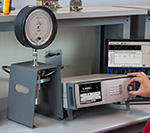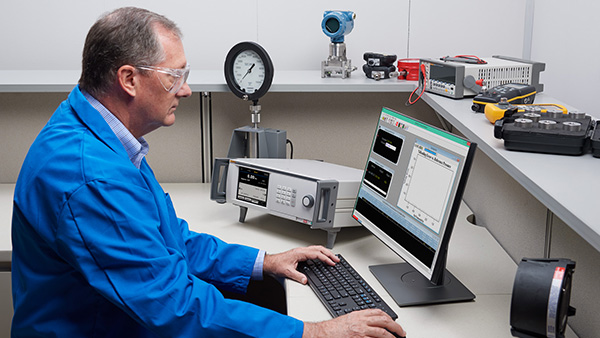- Other Fluke companies:
- Fluke
- Fluke Biomedical
- Fluke Networks
- Fluke Process Instruments
Three Reasons to Consider a Modular Pressure Control System
There are several reasons why someone might upgrade to a modular pressure control system for their existing standards. The most common are: ease of use, flexibility, and the ability to use high-pressure gas.
Fluke Calibration offers the 8270A and 8370A Modular High-Pressure Controllers as modern replacements for hydraulic deadweight testers and comparators. The 8270A and 8370A are automated pneumatic pressure controllers that can be configured with up to five measurement modules at the same time, so they can handle high pressure, low pressure, and everything in between.
Ease of Use
Unlike traditional deadweight testers and other high-pressure standards, the 8270A and 8370A have a touch screen interface, and they are easily controllable from a remote computer. Unlike pressure comparators, the process can be fully automated, and stability is achieved and maintained in a fraction of the time.
When using a deadweight tester, the metrologist needs to stack and spin weights. They have a limited time frame in which to take a pressure point. The weights need to spin continuously, and the piston needs to be floating. A controller is more straightforward. Points are easily repeated, and dwell times at pressure points can be arbitrary based on the needs of the calibration.

There are more options with a controller. Typically, customers use an 8270A or 8370A by interacting with the front panel, but they can also sit down and write custom programs to run the controller from a computer. If they’re willing to invest more time in developing ease-of-use features, they can set up test programs and store them on the calibrator itself.
For example, if a customer wanted to record five pressure points up and down the scale of their device, they could set up a stored program that would remember the process. They would set the basic configuration and give the program a name that makes sense in their context of use. The controller could then easily recall and repeat that program.
Setting up programs can be time consuming, but they can be set up incrementally. Calibration specialists don’t necessarily need to invest a lot of time up front to get started, because the device can be easily operated from the front panel.
Flexibility
If simplicity is the first key reason that someone would move to a modular pressure control system, then the second is flexibility. With a high-pressure standard like a deadweight tester, the instrument is in a fixed configuration. It has a certain pressure range, a certain accuracy, and it comes with certain things. You cannot change those factors. If your needs change, you need to buy another instrument.
The modular nature of the 8270A and 8370A high-pressure controllers means changing the configuration is as simple as buying another pressure measurement module. The modules are not matched to the controller in any way. You can easily plug in a new module at a later date.
A traditional deadweight tester requires working room to use it. A deadweight tester is inherently a tabletop instrument, and you’ll also need some bench and tabletop space to use it effectively. You’ll also need space to store weights when they’re not in use.
The 8270A and 8370A calibrators have fewer installation requirements. They can be rack mounted. You could even run the controller remotely. A deadweight tester needs to be interacted with directly, and they are susceptible to gravity effects. When you switch from a deadweight tester to a controller, gravity calculations are no longer a requirement.
High-Pressure Gas
The third most common reason to upgrade is the high-pressure gas supply. A common challenge that metrologists face, especially with hydraulic systems, is fluid incompatibilities. For example, perhaps you have a deadweight tester that uses oil, and you have a device that is required to be clean.
In cases like this, you have several options, but none of them is particularly straightforward.
- You can clean the device after calibration and validate that it’s clean.
- You could attempt to use a fluid separator.
- A fluid separator is a device with a diaphragm inside and two fluids on either side.
- It’s somewhat clumsy to use, and it adds some uncertainty to the measurement.

Using 8270A and 8370A controllers, nearly every device is going to be compatible with clean, dry gas. This system typically uses a nitrogen supply. Worries about device cleanliness are almost non-existent with a nitrogen-based system. Because the controllers go up to 15,000 PSI, they can take over a lot of the workload that would typically be handled by a hydraulic-type calibration system.
The 8270A and 8370A can also be coupled with an optional Contamination Prevention System (CPS). The CPS allows the controller to calibrate both gas-filled and liquid-filled devices without concern of contamination. With its wide pressure range coverage, one controller can accomplish the task that used to require two separate standards.
Summary
Three of the most common reasons to upgrade to a modular pressure system are: flexibility, ease of use, and the ability to use high-pressure gas to avoid contamination. Fluke Calibration offers the 8270A and 8370A Modular High-Pressure Controllers for those interested in a modern, modular system.
Automated pressure controllers are some of the simplest, easiest-to-use pressure standards. The 8270A and 8370A calibrate a wide workload of pressure sensors, covering twice the pressure ranges at twice the speed of other high-pressure controllers. The high-pressure gas supply reduces the risk of contamination, especially in high-pressure calibrations that would have traditionally required a hydraulic-type calibration system.
Keep learning
Commonly Asked Questions about the 8270A and 8370A High-Pressure Controllers
Equipment Tips for Pressure Controllers in the Production Process
Technology and Automation in Modular High-Pressure Controllers
Related products
8270A and 8370A Modular High-Pressure Controllers / Calibrators
Get Help
Speak with a calibration product expert about your equipment needs
- Home
- Products
- New Products
- Electrical Calibration
- RF Calibration
- Data Acquisition and Test Equipment
- Temperature Calibration
- Humidity Calibration
- Pressure Calibration
- Flow Calibration
- Process Calibration Tools
- Calibration Software
- Service and Support
- All Calibration Instruments
- Handheld Test Tools
- Purchase Info
- News
- Training and Events
- Literature and Education
- Service and Support
- About Us



